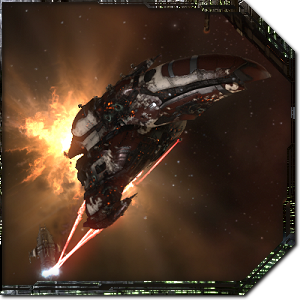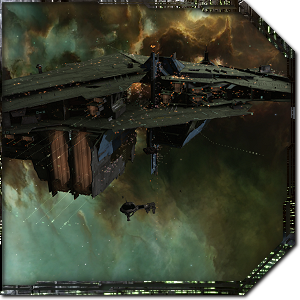
Despite this outward appearance, the past few years have seen an odd shift in EVE‘s development direction with the apparent goal of making the game a lot safer. Small improvements such as the Weapon Safety system and warning popups help prevent players from making fatal mistakes, but it’s the citadel asset safety and reinforcement timer mechanics that have been most striking. Player-built citadels are completely invulnerable for all but a few hours per week, and even attacking them in that short period is a painful experience as you have to defeat it three separate times over the span of a week and none of the station’s contents even drop as loot. Highsec is now littered with hundreds of structures that simply aren’t worth attacking, and I’m forced to ask whether the citadel reinforcement mechanics are overkill.
In this edition of EVE Evolved, I discuss gameplay being designed with loss-aversion in mind and lay out some of the problems with the citadel asset safety and reinforcement mechanics.
 Everything in EVE blows up eventually
Everything in EVE blows up eventually
There’s a saying among EVE players that you should “never fly what you can’t afford to lose,” a golden rule for not only PvP but the game in general as you’re never truly safe anywhere in the game. The way I like to put it is that the purpose of every EVE ship is to get blown up, and the goal is always to maximise what you can achieve with it before that happens. In contrast to most MMOs in which players will use the best gear they can get their hands on, EVE players are encouraged to see ships as disposable tools and select a tool of the appropriate grade based on how much ISK they’re willing to risk on a given activity.
Given that there are very few truly unique or ultra-rare ships and items in EVE, all losses of ships and assets can be seen as strict financial losses in ISK and all risks taken can be quantified. I might use a blingy navy issue battleship filled with faction gear to run missions in the relative safety of high-security space, for example, but you’ll rarely see me taking anything bigger than a cruiser out for PvP in lowsec. This has been an unspoken core principle of EVE since as far back as I can remember, and it’s always been important to EVE that players can select the levels of risk they want to take. Nobody should be able to force you to risk something without you explicitly choosing that level of risk (such as by undocking in a more expensive ship), and that guiding line has been present in EVE throughout its lifetime.
 Citadels and the selection of risk
Citadels and the selection of risk
Player-owned starbases extended this principle beyond ships and modules and into the realm of permanent assets deployed in space. Players have always had a choice of how much ISK they are willing to put at risk in a starbase, starting on the low end with a simple small tower safespot costing less than 100 million ISK and reaching up to billions of ISK in faction structures and ships and loot players routinely stored in wormhole starbases. Fast-forward to today and we now have citadels — fully dockable stations that players can open to the general public and store as many ships and items in as they like.
In an unexpected move at the time, CCP added a huge loss-avoidance mechanic to citadels in the form of Asset Safety. If a citadel is destroyed, all of the items and ships stored inside are magically whisked away by NPCs for players to recover later at their leisure. The assets are locked down for a few days and can then be moved to any other citadel or station in the system for free, or you can wait 20 days and pay 15% of the estimated market value of the items to retrieve them to the nearest safe station in another system.
This has been great for the adoption of citadels and has seen the rise of player-run trading hubs, but it feels like an abandonment of that guiding principle of risk selection as now players can choose to stage any assets they like in a citadel without worrying about the consequences. It’s worth noting that this mechanic doesn’t apply in wormhole space, where it’s expected that players know the risk they’re taking and all ships and items in the citadel will drop as loot.
 Loss-aversion and reinforcement
Loss-aversion and reinforcement
While the asset safety system can be thought of as a compromise that’s necessary in order to make players adopt the usage of publicly accessible outposts, the real problem for citadels comes in the form of the reinforcement mechanics that were broadly adapted from starbases. When CCP first introduced starbases in 2004, they decided that it wouldn’t be fair for you to wake up one morning and discover that players in another time zone had knocked down all your sandcastles. They gave starbases a reinforcement mechanic that made the structures invulnerable for about 24 hours after they were first attacked, with a clear timer displayed. This would set the time and date for the final battle over the structure and ensure that both sides would have enough time to marshal their forces if they wanted to.
Citadels use a variant of this mechanic in which the structure is invulnerable most of the time and has a short vulnerability window each week, which corporations are supposed to set to their highest activity time of the week so that they will have people online to defend. In reality, most corps just set their timers to the most inconvenient times for their enemies in order to make attacking the structures not challenging but frustrating. The game is becoming littered with time-zone tanked Astrahus citadels that are vulnerable only in a few hours in Australian peak time or when most players are asleep or in work. This kind of conflict avoidance definitely happened with starbases, but citadels have exacerbated it greatly with their second major mechanic change: multiple timers.
 Timers are grossly overused
Timers are grossly overused
When a citadel is first attacked and its shield is depleted, it enters a reinforced state and becomes invulnerable for 24 hours. The attacker then has to turn up the next day and attack it again, and once the armour is depleted it goes into a second reinforcement period for another 6 days. The final battle ends when the citadel’s structure hits 0% and it explodes, but at this point it’s been a full seven days and three full battles since that initial assault and even that first attack happens on the defender’s terms.
The attacker is forced to go through this week-long rigmarole even if the defender doesn’t turn up, and that’s a lot of effort when the thing doesn’t even drop its contents as loot. This convoluted system makes some degree of sense for large and x-large citadels that cost billions of ISK and have long vulnerability windows, but it’s total overkill for medium structures that are easily affordable by an individual. Players have even reported that there are ways to abuse the reinforcement mechanics to make citadels essentially unkillable in empire space.
What’s even more damning to me is that the tiny Mobile Depot structures that players can build just a few million ISK also use a 48 hour reinforcement mechanic and players can scoop their depots back up at any time in that period. If you’ve seen the massive signs players have built out of hundreds of Mobile Depots that nobody has the time nor the patience to clean up, you know what the end result of those mechanics are. It seems as though new gameplay is now often designed to minimise the possibility of players losing their assets altogether rather than following the age-old scheme of simply allowing players to choose their level of risk, and that’s a real shame.
Ex-community manager CCP Wrangler was famously quoted back in 2007 as saying that “EVE isn’t designed to just look like a cold, dark and harsh world; it’s designed to be a cold, dark and harsh world.” This sentiment is as true today as it was a decade ago, and yet some of the recent gameplay seems to have been designed with extraordinary risk-aversion. CCP describes EVE as a huge asymmetric board game with players placing their pieces on a single massive game board, but it’s becoming increasingly clear that many of those pieces are there only because nobody cares to remove them.
Though citadels have been widely adopted and used as everything from public trade hubs to staging areas in massive wars, the reinforcement mechanics and asset safety systems do render this fact far less impressive than it should be. In implementing catch-all defensive features such as reinforcement timers and asset safety, developers are almost depriving players of some meaningful choices and saying that everyone’s stuff must be made safe because some players would choose not to risk anything. That’s one choice I’d like the player to have to make.
 EVE Online expert Brendan ‘Nyphur’ Drain has been playing EVE for over a decade and writing the regular EVE Evolved column since 2008. The column covers everything from in-depth EVE guides and news breakdowns to game design discussions and opinion pieces. If there’s a topic you’d love to see covered, drop him a comment or send mail to brendan@massivelyop.com!
EVE Online expert Brendan ‘Nyphur’ Drain has been playing EVE for over a decade and writing the regular EVE Evolved column since 2008. The column covers everything from in-depth EVE guides and news breakdowns to game design discussions and opinion pieces. If there’s a topic you’d love to see covered, drop him a comment or send mail to brendan@massivelyop.com!















